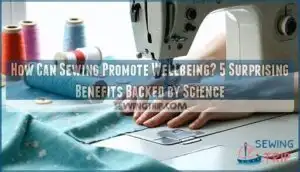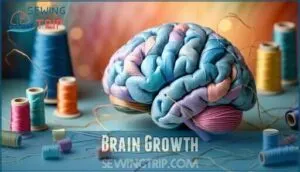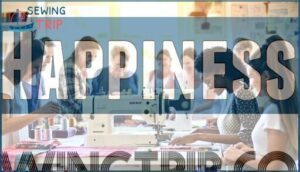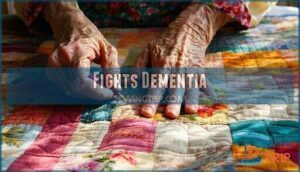This site is supported by our readers. We may earn a commission, at no cost to you, if you purchase through links.

Science now agrees: those tiny, repetitive movements kickstart noticeable changes upstairs, tuning coordination, boosting memory, and even keeping mental cobwebs at bay. If you’ve ever wondered how sewing could quietly transform not just what you create but how you feel, the evidence is right there in each seam—along with a few surprises waiting to be unraveled.
Table Of Contents
Key Takeaways
- Sewing offers surprisingly powerful stress relief, turning anxious energy into calm focus with each mindful, repetitive stitch.
- Your hand-eye coordination and cognitive skills get a real workout, sharpening focus, dexterity, and even staving off mental decline.
- Every project you finish boosts not just your sense of accomplishment, but your overall happiness and sense of belonging, especially when you share in a creative community.
- Sewing is more than a hobby—it’s active brain therapy, sparking new neural connections and protecting memory, making it a quiet ally in dementia prevention.
Stress Relief
Few things match the subtle magic of sitting down to sew when stress tries to take center stage. Mindful stitching, with its gentle rhythm, acts as a kind of sewing meditation—a tactile grounding technique you can literally feel.
Sewing turns anxious thoughts down a notch, letting them settle while your hands keep busy. Each stitch becomes a creative outlet and a practical stress management technique rolled into one.
Don’t underestimate those quiet moments: science shows measurable stress reduction and even relaxation responses similar to deep breathing, all while you create something entirely your own. In fact, sewing can be a great way to reduce symptoms of anxiety.
Improved Hand-eye Coordination
As you sink into the peaceful rhythm of your project, you might notice something else clicking into place—your hands and eyes are moving together in a new, almost magical way.
Precision sewing calls on your visual acuity and sharpens hand-eye coordination with every pinpoint adjustment. It’s not just about getting straight seams; you’re actively refining motor skills and enhancing dexterity as you go.
Each careful stitch is brain exercise—boosting cognitive dexterity and extending your mind’s problem-solving reach. Like learning to play the piano or throwing a ball, sewing gently tunes your body and mind, promoting real improvements in cognitive function.
Brain Growth
Now that your hands and eyes are working together, let’s talk about what’s happening upstairs—your brain is reaping big rewards, too. Sewing isn’t just a hands-on task; it’s a brain builder. When you tackle new patterns or invent color combinations, you’re sparking fresh neural connections and fueling brain growth. Try a tricky hem or invent a design, and you’re stretching your cognitive flexibility in ways that matter for lifelong learning.
One key benefit is the ability to achieve a state of flow, enhancing focus and enjoyment. Why does this all matter for you? Because brain stimulation through sewing offers:
- Memory improvement through challenging pattern work
- Heightened cognitive function
- Ongoing brain cell growth
Happiness
Just when you think sewing is all about brainpower, it turns out it’s also a shortcut to genuine happiness—one stitch at a time. Each steady pull of thread weaves contentment into your day, giving you an Accomplishment Boost that lingers long after the last knot.
Sewing sparks emotional wellbeing and memory evocation—maybe Grandma’s favorite quilt or your child’s first costume.
Better yet, this craft is a passport to Social Connection, wrapping you in a supportive community that celebrates joy and elevates mental wellbeing.
Fights Dementia
While you might reach for a needle and thread on rainy afternoons, you’re actually giving your brain a serious workout. Sewing provides more than just creative satisfaction—it’s an act of Dementia Prevention through everyday cognitive stimulation.
Each stitch you make gets your brain moving in new ways.
- Neural plasticity and flexibility
- Hands-on memory improvement
- Sensory-rich cognitive stimulation activities
- Enhanced problem-solving for cognitive benefits
- Gentle weaving of connections, slowing cognitive decline
That’s why sewing stands as a powerful tool for memory stimulation and preserving your brain’s vitality.
Frequently Asked Questions (FAQs)
How does sewing help with building social connections?
Picture a sewing circle as the original group chat—only with real thread and coffee. Community building springs to life here, as quilting groups, sewing clubs, and online sewing communities foster rich skill sharing and meaningful intergenerational connections.
Can sewing boost self-confidence and self-esteem?
Every time you finish a sewing project, you’re racking up wins—Skill Mastery, Project Completion, and Creative Expression.
That sense of accomplishment, plus a dose of Positive Reinforcement, weaves selfesteem and selfconfidence right into your Personal Identity.
What therapeutic effects does sewing have on anxiety?
Sewing offers anxiety reduction by turning repetitive stitches into a mindfulness practice.
Sewing can be a dependable way to manage stress, giving you a chance to calm your mind, relax, and channel nervous energy into something creative and fulfilling.
How does sewing support personal growth and resilience?
Chasing that perfect seam nurtures more than fabric—it sparks self-discovery, builds confidence, and quietly coaches emotional regulation.
Each project nudges problem solving and lifelong learning, weaving personal growth and resilience through skill development and creativity, one stitch at a time.
In what ways can sewing foster community involvement?
Like threads weaving a strong fabric, sewing circles, charity projects, and community quilts spark social connections, bridge generations, encourage skill sharing, and—thanks to online sewing communities—bring people together, building community support both in-person and digitally.
Conclusion
Between tangled threads and neatly finished seams, something quietly special happens: frustration transforms into focus, impatience yields to a meditation-like calm.
Sewing isn’t just about what your hands make—it’s a hands-on answer to how can sewing promote wellbeing. The science proves it, but so do the smiles of makers everywhere.
In each stitch, you’ll find evidence of resilience, growth, and delight, waiting for your fingertips. Who knew a simple act could unravel anxiety and stitch together joy?
- https://pubmed.ncbi.nlm.nih.gov/39008815/
- https://mimihali.com/blogs/news/the-mental-health-benefits-of-hand-sewing-how-mindful-stitching-supports-calm-focus-and-well-being
- https://www.moodfabrics.com/blog/the-healthy-benefits-of-sewing/
- https://craftychica.com/2018/06/sewing-for-stress-relief/
- https://www.sewnsew.net.au/health-benefits-of-sewing/









